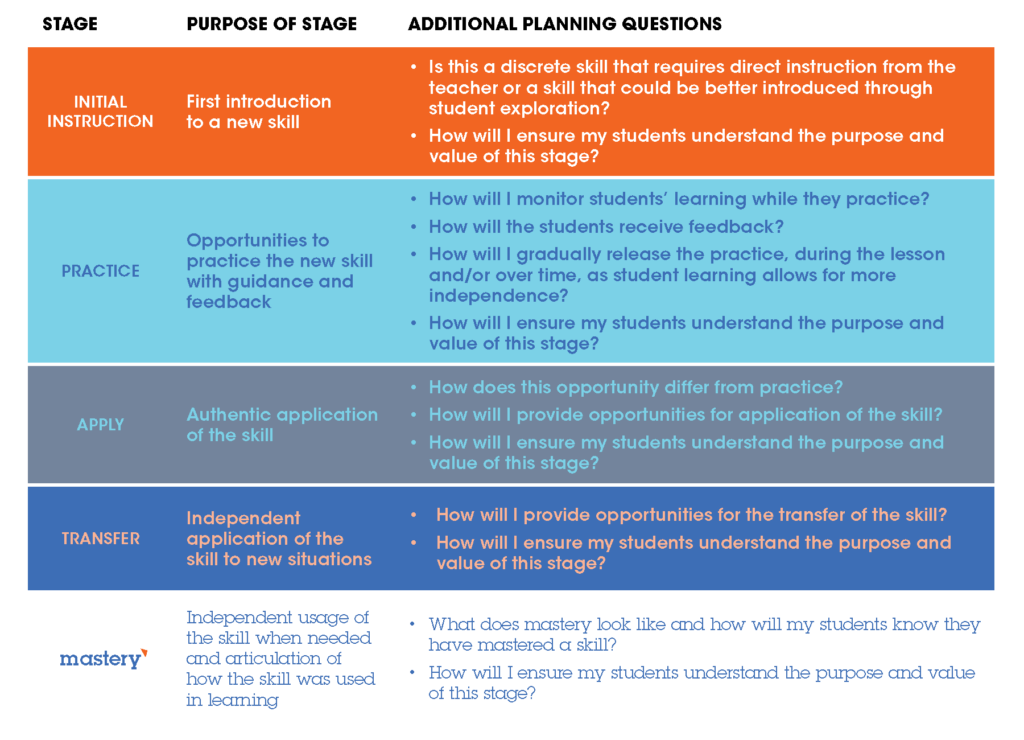Share this article.
We all recognize that real learning is a process. Rarely do students master a skill at first encounter. They need time and opportunities to practice skills with varying degrees of challenge and success. In other words, it’s a process that requires intentional planning.
Teachers need to determine where their students are in the learning process and reflect on why their students mastered certain skills or not and what skills their students need more opportunities with to develop mastery.
For example…
If students were never taught a specific skill last semester, they will need initial instruction on this skill.
If students were taught a skill last semester but didn’t have a chance to consistently engage with it, they will need more time to practice.
If students were taught a skill but didn’t have an opportunity to use it, they will need to apply that skill in authentic situations.
If students were taught a skill and showed mastery in one class, they will need to be taught to transfer these skills into other content areas or situations.
But regardless of where your students fall in the learning process, your charge and commitment remain the same—to ensure your students are supported with multiple and varied opportunities to utilize skills until they are mastered. The good news is the decisions about what your students need to learn and what you can do to support your students’ learning are in your hands.
So, how do can you leverage what we know about learning to make decisions? How can we support you to proactively plan for a progression that ensures mastery? Keep reading.
The Stages of the Learning Process
First, consider the learning process—those stages that any learner follows to acquire a new skill to mastery.

- Initial Instruction: the stage when learners first hear about a new skill and how to acquire it
- Practice: the stage when learners have multiple and various opportunities to practice the new skill with guidance and feedback
- Apply: the stage when learners have opportunities to authentically apply the new skill
- Transfer: the stage when learners understand how to transfer the skill into various situations
- Mastery: the stage when learners independently use the skill and can articulate how the skill was used in learning
This sequence of stages is built upon the notion of conceptual redundancy of the skill or content being learned. This sequence ensures that students have opportunities for repetition with the same concept in a variety of approaches, including opportunities to learn the skill initially, practice the skill, apply the skill, and then transfer the skill across time and situations. Once learners have completed each of these stages, they can say, with evidence, that they have mastered the skill. We call this the Mastery Sequence.
The Responsibilities for Teachers and Students in the Mastery Sequence
At the beginning of the school year, the stages in the Mastery Sequence should be explained by the teacher. Students are better able to own their learning if they have a clear understanding of what the Mastery Sequence is and where they are as they progress toward greater student ownership.
However, it is not solely the teacher’s responsibility to drive all of the learning. In order for the learning to be effective, the students will have to take charge of some stages of this sequence themselves as they build ownership of their learning. It is the responsibility of the teacher to use the data regarding where students are in their learning to make the decisions around what skills to teach, what order to teach them in, which stages in the Mastery Sequence to release responsibility to the students, and how to communicate these decisions to the students. If students know where they are in the Mastery Sequence, they will know they have more opportunities to master the skills they need to master.
How to Proactively Plan
Your task is to ensure that your students understand the Mastery Sequence, the purpose of each stage, and the value of looking at learning as a continuous cycle of growth. Then, you must plan your units and lessons to support this understanding.
For each stage of the learning process teachers will need to ask themselves:
- What is the learning outcome of this stage?
- What will students need to show to demonstrate learning?
- What will be the role of the teacher?
- What will be the role of the student?
- How will I communicate this information to my students?
 The Advantages of Proactive Planning
The Advantages of Proactive Planning
Planning can feel daunting, but utilizing the Mastery Sequence can provide both students and teachers with expanded opportunities. This could include freeing up time for teachers to work with students individually or providing additional opportunities for students to collaborate with classmates. The increased responsibility for students in the learning process will create independence and ownership of their learning.
All of this requires thoughtful planning; planning that ensures that your students will end up being part of the most independent generation of learners we have ever produced. Thus, as we all plan this year, it is imperative for teachers and students to know where they are in the learning process and how they will be supported to achieve mastery each and every day. But regardless of where your students fall in the Mastery Sequence, your charge and commitment remain the same—to ensure your students are supported with multiple and varied opportunities to utilize skills until they are mastered. The good news is the decisions about what your students need to learn and what you can do to support your students’ learning are easy to make when you have a model that supports student ownership within daily lessons.
Continue the Learning
Check out these articles and resources to continue your learning about this topic…
The Learning Brief
In this article you learned…
- The benefits of proactive planning.
- The five stages of the Mastery Sequence.
- How to leverage the stages of the Mastery Sequence when planning and teaching to empower students to own their learning.
Can you imagine building an environment full of motivated, engaged, and eager students who own their learning?
We can.

